
The longhorn beetles (Cerambycidae), also known as long-horned or longicorns, are a large family of beetles, with over 35,000 species described.
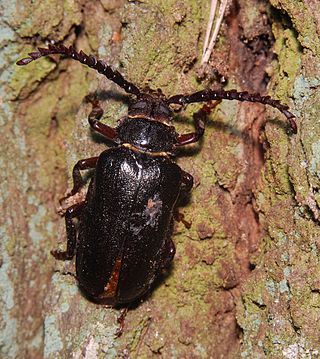
Prionus coriarius is a species of longhorn beetle.

Spodoptera litura, otherwise known as the tobacco cutworm or cotton leafworm, is a nocturnal moth in the family Noctuidae. S. litura is a serious polyphagous pest in Asia, Oceania, and the Indian subcontinent that was first described by Johan Christian Fabricius in 1775. Its common names reference two of the most frequent host plants of the moth. In total, 87 species of host plants that are infested by S. litura are of economic importance. The species parasitize the plants through the larvae vigorous eating patterns, oftentimes leaving the leaves completely destroyed. The moth's effects are quite disastrous, destroying economically important agricultural crops and decreasing yield in some plants completely. Their potential impact on the many different cultivated crops, and subsequently the local agricultural economy, has led to serious efforts to control the pests.

Mocis frugalis, the sugarcane looper, is a moth of the family Erebidae. The species was first described by Johan Christian Fabricius in 1775. It is found in several parts of the world, including India, Sri Lanka, West African countries and other Oriental regions. The adult is a fruit piercer and a major pest of crops.

Pheidole megacephala is a species of ant in the subfamily Myrmicinae. It is commonly known as the big-headed ant in the US and the coastal brown ant in Australia. It is a very successful invasive species and is considered a danger to native ants in Australia and other places. It is regarded as one of the world's worst invasive ant species.
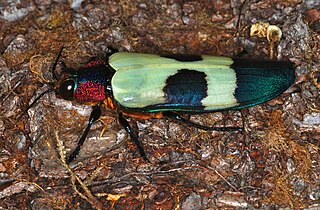
Chrysochroa buqueti, the red speckled jewel beetle, is a Southeast Asian species of beetle in the Buprestidae family and tribe Chrysochroini. It is found for example in Borneo and Malaysia.

Enoplocerus is a genus of longhorn beetles in the subfamily Prioninae of the family Cerambycidae. It is monotypic, being represented by the single species Enoplocerus armillatus, commonly known as the giant longhorn beetle or imperious sawyer.
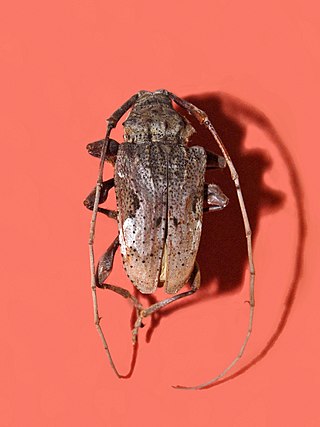
Lagocheirus araneiformis is a species of longhorn beetle of the subfamily Lamiinae. It was described by Carl Linnaeus in his 1767 12th edition of Systema Naturae.
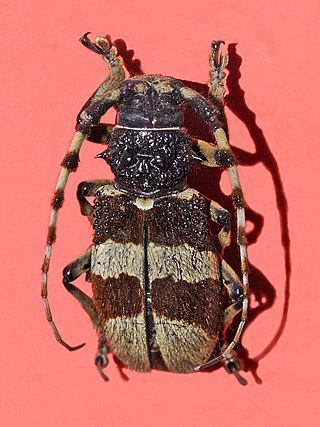
Arctolamia fasciata is a species of flat-faced longhorn beetles belonging to the family Cerambycidae.
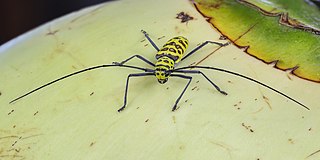
Gerania bosci is an Asian species of flat-faced longhorn beetle in the subfamily Lamiinae. It is the only species in the genus Gerania.
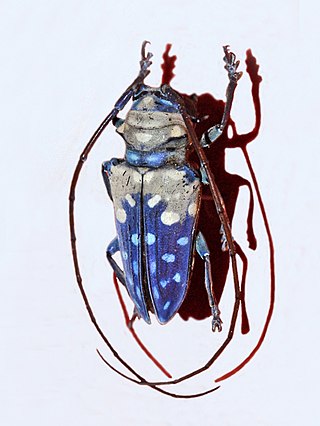
Sternotomis variabilis, the Lesser Jewel Longhorn Beetle, is a species of flat-faced longhorn beetles belonging to the family Cerambycidae.

Sternotomis itzingeri is a species of flat-faced longhorn beetles belonging to the family Cerambycidae.
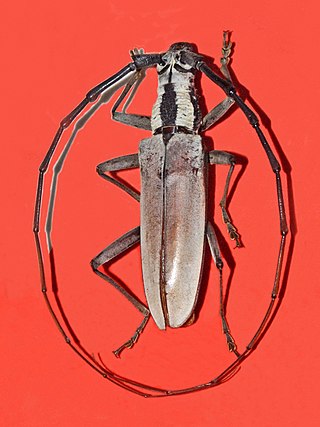
Massicus pascoei is a species of round-necked longhorn beetles of the subfamily Cerambycinae.
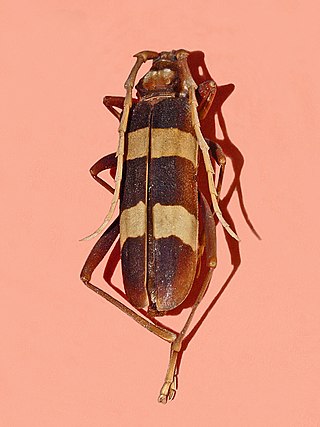
Aphrodisium griffithi, the Veined Capricornbeetle, is a species of round-necked longhorn beetles of the subfamily Cerambycinae.

Pachyteria dimidiata, the mimusop stem borer, is a species of round-necked longhorn beetle of the subfamily Cerambycinae.
Chilo auricilius, the gold-fringed rice stemborer or terai borer, is a moth in the family Crambidae. It was described by Gerald C. Dudgeon in 1905. It is found in India, Taiwan, Bhutan and Sri Lanka, as well as on Sulawesi, Borneo, Sangir Island and the Moluccas. The larvae bore into and feed on the stems of various grass family plants including sugarcane, rice and maize.
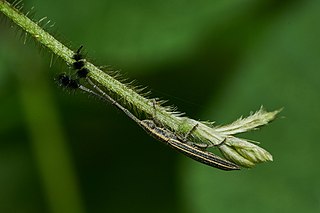
A stemborer is any insect larva, or arthropod, that bores into plant stems. However the term most frequently refers among the Coleoptera to the larva of certain longhorn beetles such as Dorysthenes buqueti and those of the genus Oberea, and among the Lepidoptera to certain moths of the Crambidae, Castniidae, Gelechiidae, Nolidae, and Pyralidae families.
Anoplognathus aureus, commonly known as the gold Christmas beetle, is a beetle of the family Scarabaeidae native to northern Australia, from northeastern Queensland to northern Western Australia. It is prized by collectors.
Sturmiopsis inferens is a species of fly in the family Tachinidae. It is native to Asia and is a parasitoid of various moth species whose larvae feed inside the stems of sugarcane, rice and other large grasses, including the Gurdaspur borer and the sugarcane shoot borer.
Pyrilla perpusilla, commonly known as the sugarcane planthopper, is a planthopper in the family Lophopidae. It is native to Asia where it feeds on grasses and other plants and is a major pest of sugarcane and sorghum.
















